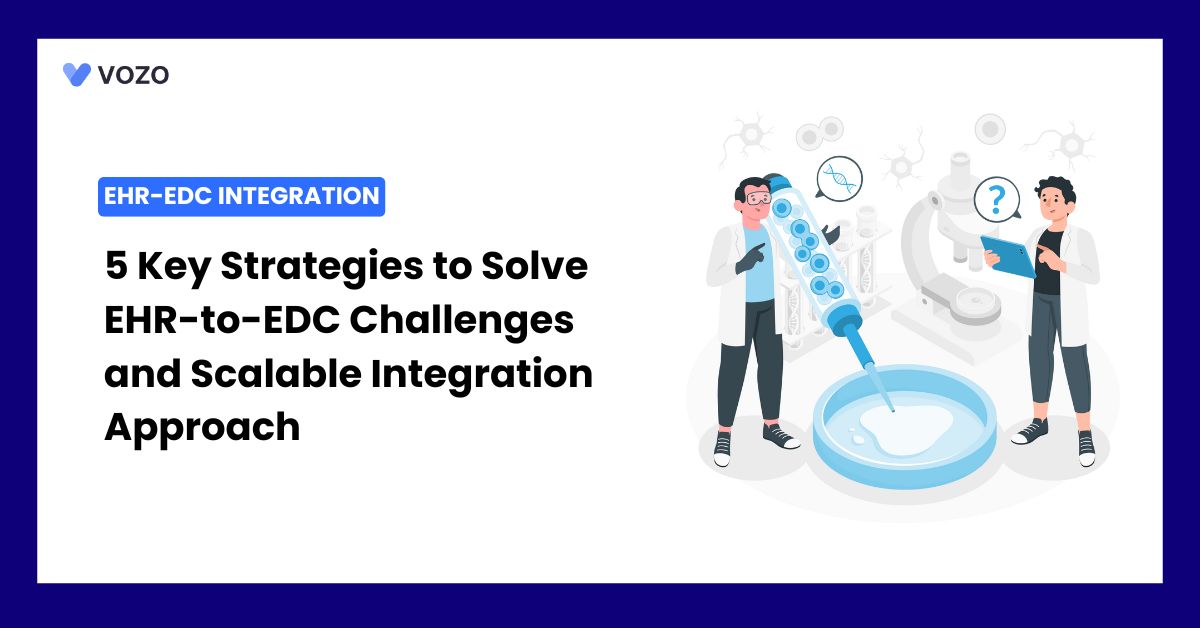5 Key Strategies to Solve EHR-to-EDC Challenges and Scalable Integration Approach
Electronic Data Capture system offers a higher amount of benefits for clinical research. According to market analysis, the EDC system market was valued at $1.7 billion in 2023 and is expected to reach $3.81 billion in 2031.
However, in the current onset of EHRs in the healthcare system diagram, clinical research has strained and been slowed down to embrace the systems. Even though they are acknowledged as a very valuable source of data that offers numerous advantages for clinical research, especially when integrating EHRs with EDCs.
In this blog post, we have shared the benefits of EHR-EDC integration, common challenges in integration, and key strategies to overcome these barriers.
What is Electronic Data Capture?
Electronic Data Capture is a system mainly used in clinical trials because it assists in ordering data during a trial.
Thus, while using the abbreviation, EDC only saves time on data entry in biopharmaceutical organizations, pharmaceutical companies, medical device manufacturers, and contract research organizations.
It eases the process of collection as against the use of paper-based data entry and allows for an easier collection process, unlike paper-based data entry.
EDC systems provide a range of data entry, validation, de-identification, and reporting tools that enable:
- Real-time data processing
- Minimizing human errors
- This would accelerate the marketing of new drugs and medical devices.
It is truly important because advancements in drug monitoring clinical research and pharmacovigilance require speedier data collection and accuracy.
Benefits of Integrating EHR and EDC Systems
1. Minimizing Manual Data Entry and Reducing Errors
- Incorporating EHRs into EDC systems can transfer data more directly from the clinical care settings to the clinical research databases.
- So, the a need for labor-intensive and error-prone repetitive manual entry.
- Direct transfer of data shall now provide higher accuracy for the researchers making the discrepancies lower and validation processes related to data quality streamlined to ensure that cleaner and more reliable data are obtained for the clinical trials.
2. Enhancing Clinical Trial Efficiency and Reducing Costs
- EHR and EDC integrations ensure optimized efficiency for clinical trials.
- Automating data collection while minimizing manual handling reduces operational costs associated with the handling of data management and processing.
- Efficient data entry and reporting features provided by EDC enable research teams to allocate their resources better and thus accelerate timelines for trials as well as overall expenses.
- Fast, cost-effective data processing supports faster and quicker approvals, resulting in more lives saved sooner.
3. Expanding Research Scope and Improving Patient Recruitment
- Accessing a larger patient database through EHR-EDC integration can thus enable more extensive research scopes, which may be wider and more inclusive.
- The increase in the availability of various data will help in making it easier to list down eligible patients hence improving the rate of clinical trial recruitment.
- The use of EHR data for patient attributes, medical histories, and more information will aid in the identification of more diverse participants and increase the generalization of clinical trial results.
EHR-to-EDC Integration Challenges
1. Lack of Interoperability Between EHR and EDC Systems
- One major challenge to successful EHR-EDC integration is the lack of interoperability.
- EHR and EDC systems often use different platforms and standards, making data exchange challenging.
2. Data Quality and Standardization Issues
- EHR and EDC systems often have different data structures, standards, and terminologies.
- This ultimately creates challenges in data consistency and quality.
- The lack of uniform standards can result in errors or mismatches during data transfer thus affecting the integrity of the research data.
Related: 6 Strategies for Easily Extract Data from EHR
3. Complexity of Managing Large Volumes of Clinical Data
- Clinical trials yield larger datasets than ever before given the massive adoption of digital health technologies.
- This can overwhelm EDC systems if systems are not built for high volumes.
- Integration of EHR data into EDC requires enhancements in data filtering, aggregation, and storage capabilities to effectively manage these volumes.
Key Strategies for Overcoming EHR-to-EDC Challenges
1. Leveraging API-Enabled “Read” Services for Data Exchange
- API-enabled “read” services simplify the transfer of data by providing a standardized way for EHRs to share information with EDC systems.
- These APIs allow real-time, on-demand access to EHR data that enables a faster and more accurate data exchange.
2. Adopting HL7 FHIR Standards to Streamline Data Integration
- The HL7 FHIR standard offers a solution to interoperability issues by structuring data in a universally accepted format.
- FHIR simplifies data mapping between EHR and EDC systems.
- Adopting FHIR means clinical research organizations can create more scalable and repeatable integration solutions.
3. Building Scalable and Standardized Data Mapping Protocols
- Implementing scalable and standardized data mapping protocols helps ensure that data from EHRs aligns seamlessly with EDC requirements.
- These protocols reduce the need for trial-specific customization.
- This allows clinical research teams to manage data integration more effectively.
4. Implementing Robust Data Quality Controls and Validation
- Effective data quality controls are essential for maintaining accuracy in EHR-to-EDC data transfers.
- Automated quality checks and validation protocols ensure that only reliable and consistent data is used in clinical research.
- Implementing these controls at each stage of data transfer increases the confidence in clinical data findings.
5. Using Interoperability Engines for Seamless Data Flow
- Interoperability engines make it easier for seamless data exchange between EHR and EDC systems regardless of format differences.
- By bridging data standards and automating transformation, these engines allow real-time data integration across multiple sources.
About the author

With more than 4 years of experience in the dynamic healthcare technology landscape, Sid specializes in crafting compelling content on topics including EHR/EMR, patient portals, healthcare automation, remote patient monitoring, and health information exchange. His expertise lies in translating cutting-edge innovations and intricate topics into engaging narratives that resonate with diverse audiences.













